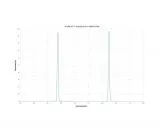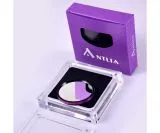- Details
- More images
Products description
Antlia ALP-T 2" Dual Band narrow band nebula filter - S-II and H-Beta, 5nm
The 2" narrow-band nebula filter enables nebula photography with extreme contrast with MONO and COLOR cameras - light pollution is no longer an issue.
♦ 2" low-profile filter mount with M48x0.75 thread
♦ Can be used for telescopes and lenses with an aperture ratio of f/3 and slower
♦ Optical Schott base substrate
♦ Blackened edges to avoid internal reflections
♦ Extremely narrow bandwidth of only 5 nm for maximum contrast
♦ Precise passage in S-II and H-Beta
♦ Filter thickness 2 mm
♦ Supplied in a practical plastic transport box
♦ The images are for demonstration only.
Antlia ALP-T dual-band 5nm narrow-band nebula filter for B&W and color cameras
Antlia developed this 5nm dual line pass filter for color one-shot cameras (OSC), DSLR and mirrorless system cameras. However, it can also be used as a narrow-band filter for monochrome cameras to save valuable recording time and produce extremely high-contrast luminance images, even in moonlight and near cities.
The ALP-T dual-band filter transmits the red S-II light (672.4 nm) and the green H-Beta light (486.1 nm) and blocks all other wavelengths. In particular, the unwanted wavelengths of light pollution and airglow are blocked. This allows you to capture deep, deep-sky images even in moonlight and near cities. The signal-to-noise ratio is greatly increased and so even the faintest fog can be worked out.
The filter is an important addition to the popular Antlia ALP-T dual band 5 nm Ha&OIII filter. The combination of these two dual-band filters enables extremely narrow-band images with OSC cameras by acquiring the spectral data of 4 channels i.e. H-alpha/O-III/S-II/H-beta. The spectrum of these four channels can be broken down into different color palettes and recombined in post-processing. The resulting images can be used to enhance the luminance contrast of traditional RGB balanced images or to create images in various popular false color palettes such as H-O-Hb, S-H-O, H-S-OHb, H-O-O, etc.
Why are S-II and H-Beta bands passed instead of O-III and S-II bands?
The filter is designed to capture H-beta and S-II emission lines. We know that S-II is simply ionized sulfur that emits light in the far-red part of the spectrum beyond H-alpha, but H-beta's contribution to emission lines in nebulae is often overlooked, even though it is the second most abundant hydrogen emission after H -alpha line is. Acquiring more O-III amplifies the existing signal but provides no additional information. However, H-beta has the potential to reveal structures not visible with O-III. The design aims to capture the H-beta emission line in certain nebulae that contain some blue spectrum that H-alpha, S-II and O-III filters cannot capture. In many foggy images, larger and richer details are captured to produce results with better signal-to-noise ratios.
It is generally accepted that the O-III signal makes a relatively weak contribution to fog images. The sensitivity of the O-III bandpass is an important factor for any nebula filter. Most color cameras (OSC) use an RGGB Bayer pattern. Using twice as many green pixels as compared to red or blue pixels allows for much better capture of the O-III signal. In addition, a higher O-III signal can be achieved by an additional exposure with the Antlia ALP-T Ha&O3 filter. Then the GB channels are isolated and an O-III channel is synthesized, which is added to the stack.
If you only want to add S-II to your H-alpha and O-III data, it's probably better to buy a narrow-band S-II filter and get a cleaner S-II spectral emission. However, Antlia's new filter design (SII&Hb) also includes the H-beta emission line, resulting in a significant improvement in the contrast of nebulae and better separation of structures in H-beta areas.
The quality features of Antlia narrowband filters at a glance:
♦ High light transmission and narrow bandwidth to maximize contrast
♦ Steep spectral profile minimizes halos around bright stars
♦ A single substrate to eliminate internal reflections
♦ Use in light polluted areas and dark places
♦ Extends recording time under moonlight
♦ Antlia Narrow Band Pro filters can be used down to f/3 systems with little signal loss
♦ All Antlia narrowband filters are edge blackened to eliminate internal reflections of stray light
♦ Superior optical reliability reduces post-processing of the image
Substrate: Optical substrate from Schott
Filter Thickness: 2mm
Socket: Low-profile metal socket with M48x0.75 filter thread
Bandwidth: 5nm
Central wavelengths: 672.4 nm (90% maximum transmission), 486.1 nm (85% maximum transmission)
Blocking of unwanted wavelengths: >= OD4.5
Surface quality: S/D (scratch/dig)= 60/40 (Refer to MIL-O-13830)
Surface Accuracy: Lambda/4 or better
♦ Filters
♦ Filter box
The 2" narrow-band nebula filter enables nebula photography with extreme contrast with MONO and COLOR cameras - light pollution is no longer an issue.
♦ 2" low-profile filter mount with M48x0.75 thread
♦ Can be used for telescopes and lenses with an aperture ratio of f/3 and slower
♦ Optical Schott base substrate
♦ Blackened edges to avoid internal reflections
♦ Extremely narrow bandwidth of only 5 nm for maximum contrast
♦ Precise passage in S-II and H-Beta
♦ Filter thickness 2 mm
♦ Supplied in a practical plastic transport box
♦ The images are for demonstration only.
Antlia ALP-T dual-band 5nm narrow-band nebula filter for B&W and color cameras
Antlia developed this 5nm dual line pass filter for color one-shot cameras (OSC), DSLR and mirrorless system cameras. However, it can also be used as a narrow-band filter for monochrome cameras to save valuable recording time and produce extremely high-contrast luminance images, even in moonlight and near cities.
The ALP-T dual-band filter transmits the red S-II light (672.4 nm) and the green H-Beta light (486.1 nm) and blocks all other wavelengths. In particular, the unwanted wavelengths of light pollution and airglow are blocked. This allows you to capture deep, deep-sky images even in moonlight and near cities. The signal-to-noise ratio is greatly increased and so even the faintest fog can be worked out.
The filter is an important addition to the popular Antlia ALP-T dual band 5 nm Ha&OIII filter. The combination of these two dual-band filters enables extremely narrow-band images with OSC cameras by acquiring the spectral data of 4 channels i.e. H-alpha/O-III/S-II/H-beta. The spectrum of these four channels can be broken down into different color palettes and recombined in post-processing. The resulting images can be used to enhance the luminance contrast of traditional RGB balanced images or to create images in various popular false color palettes such as H-O-Hb, S-H-O, H-S-OHb, H-O-O, etc.
Why are S-II and H-Beta bands passed instead of O-III and S-II bands?
The filter is designed to capture H-beta and S-II emission lines. We know that S-II is simply ionized sulfur that emits light in the far-red part of the spectrum beyond H-alpha, but H-beta's contribution to emission lines in nebulae is often overlooked, even though it is the second most abundant hydrogen emission after H -alpha line is. Acquiring more O-III amplifies the existing signal but provides no additional information. However, H-beta has the potential to reveal structures not visible with O-III. The design aims to capture the H-beta emission line in certain nebulae that contain some blue spectrum that H-alpha, S-II and O-III filters cannot capture. In many foggy images, larger and richer details are captured to produce results with better signal-to-noise ratios.
It is generally accepted that the O-III signal makes a relatively weak contribution to fog images. The sensitivity of the O-III bandpass is an important factor for any nebula filter. Most color cameras (OSC) use an RGGB Bayer pattern. Using twice as many green pixels as compared to red or blue pixels allows for much better capture of the O-III signal. In addition, a higher O-III signal can be achieved by an additional exposure with the Antlia ALP-T Ha&O3 filter. Then the GB channels are isolated and an O-III channel is synthesized, which is added to the stack.
If you only want to add S-II to your H-alpha and O-III data, it's probably better to buy a narrow-band S-II filter and get a cleaner S-II spectral emission. However, Antlia's new filter design (SII&Hb) also includes the H-beta emission line, resulting in a significant improvement in the contrast of nebulae and better separation of structures in H-beta areas.
The quality features of Antlia narrowband filters at a glance:
♦ High light transmission and narrow bandwidth to maximize contrast
♦ Steep spectral profile minimizes halos around bright stars
♦ A single substrate to eliminate internal reflections
♦ Use in light polluted areas and dark places
♦ Extends recording time under moonlight
♦ Antlia Narrow Band Pro filters can be used down to f/3 systems with little signal loss
♦ All Antlia narrowband filters are edge blackened to eliminate internal reflections of stray light
♦ Superior optical reliability reduces post-processing of the image
Substrate: Optical substrate from Schott
Filter Thickness: 2mm
Socket: Low-profile metal socket with M48x0.75 filter thread
Bandwidth: 5nm
Central wavelengths: 672.4 nm (90% maximum transmission), 486.1 nm (85% maximum transmission)
Blocking of unwanted wavelengths: >= OD4.5
Surface quality: S/D (scratch/dig)= 60/40 (Refer to MIL-O-13830)
Surface Accuracy: Lambda/4 or better
♦ Filters
♦ Filter box
This Product was added to our catalogue on 14/05/2023.
Categories
Quick purchase
Welcome back!
Last viewed:
Manufacturer
Shipping country




